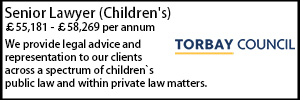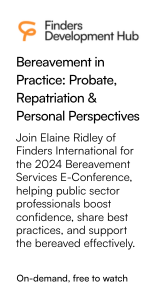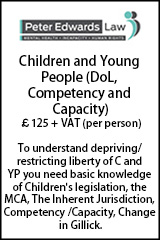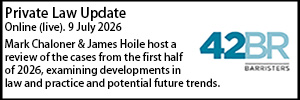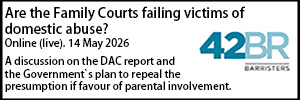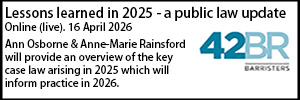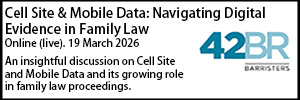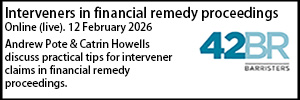Council ordered to undertake re-assessment of age of asylum seeker
- Details
The High Court has ordered Dorset Council to undertake a re-assessment of an asylum seeker’s age, which takes account of new evidence in the form of an Afghan national identity card and three reports relating to it.
In MIA, R (On the Application Of) v Dorset Council [2025] EWHC 1324 (Admin) (16 April 2025), His Honour Judge Dight expressed “no view” as to the correctness of the original age assessment decision, but said he had “no doubt that the taskira is a piece of evidence which triggers a re-assessment”.
The claimant in the case was an unaccompanied asylum seeker who said that at all material times since arrival in the United Kingdom in the summer of 2023 he has been a child, whereas the council maintained that at all material times he has been an adult.
The judge noted: “The claimant says that he was aged 16 on arrival whereas the age assessment carried out on behalf of the defendant, giving him an assumed birth date of 1 January 2000, would put the claimant at around 23 on arrival.
“The claimant's challenges are not to the age assessment itself (he being out of time to bring such a challenge) but to the two refusals by the defendant to re-assess his age notwithstanding the provision by his solicitors of what is agreed to be new evidence.”
The new evidence was submitted in the form of an Afghan national identity card known as a taskira, which said it was issued on 16 April 2017 (stating that the claimant was aged 10 years old at the date of issue), alongside two expert reports (the first submitted on 28 March 2024 and the second on 24 April 2024) confirming that in the view of the experts the taskira provided by the claimant was genuine.
The judge noted: “The taskira, if the information which it bears is accurate, therefore indicates that the claimant was indeed aged 16 on arrival in the UK.”
Outlining the position of the council, the judge said: “At the hearing before me the defendant confirmed what it had already said in the Decisions, namely that it did not challenge the genuineness of the taskira. The defendant's counsel also accepted the date on which it was stated to have been issued and that the discovery and production of the taskira was a relevant matter in considering whether to re-assess the claimant's age.
“The essence of the defendant's position is that the information contained in or on the taskira cannot be shown to have been compiled in an appropriate way and the document is not, therefore, a reliable piece of evidence as to the true age of the claimant and it therefore follows that receipt by the defendant of a copy of the taskira did not give rise to an obligation to re-assess the claimant's age.”
The claimant however submitted that the decisions were unlawful because the council misapplied the applicable re-assessment test and thereby (i) departed from established case law, (ii) failed to follow applicable guidance and that in any event the decisions were “irrational”.
The judge noted: “The essence of the claimant's challenge on process irrationality is that the defendant misdirected itself in applying what is known as the Age Assessment Guidance by asking itself not whether the evidence was capable of resulting in a significantly different conclusion as to the claimant's age but whether it did or would do so. The claimant submits that the defendant conflated two questions, first the question whether it should re-assess and secondly what the outcome of a re-assessment would be whereas it should have focused first on the question of whether there should be a re-assessment.”
He added: “The claimant also argues that the outcomes of the decisions were irrational in that they were unreasonable in the Wednesbury sense because the defendant had criticised the absence of a taskira, but when the taskira, which is plainly a document capable in theory of evidencing the claimant's correct age, was produced it did not trigger a re-assessment.”
Analysing the case, the judge noted that the Association of Directors of Children’s Services (ADCS) Guidance covers not only age assessment, but the approach and steps which should be taken if new information comes to light after an initial age assessment.
He said: “A question arises in this case as to the extent to which the defendant was bound to follow the Guidance in relation to the decision not to re-assess.”
Outlining key areas of the guidance, the judge said under the heading "Where further information becomes available", the Guidance suggests the following approach:
"Age assessment is a difficult process for children and young people and for social workers undertaking the assessment it should only be undertaken when there is significant reason to do so. However, there will be occasions when a further assessment is required. Other than on those occasions when reliable and authoritative information is available, an assessment will not allow the assessing social workers to know the age of a child or young person and will only allow them to come to a balanced and reasonable conclusion based on the information to hand and on the benefit of the doubt. Other information may come to light at a later stage, for example, in the form of documentation or as professionals get to know the child or young person over time, which leads them to think that the assessed age is wrong."
The section then goes on to identify the trigger for a re-assessment and the steps which it should lead to:
"Where you believe that a significantly different conclusion might be reached and that the child or young person may be notably older or younger than initially assessed, then a new assessment should be undertaken. [judge’s underlining] In most circumstances you will need to talk with the young person about this new information. There may be occasions when a re-assessment does not have to involve further questioning; for example, where new documentation has been provided which supports the child or young person's claim and it can be relied upon, a decision on age can be made on that basis. Any new decision and the reasons for it must be clearly communicated with the child or young person, and if they are to remain in your service, then thought must be given to rebuilding trust and confidence. The Home Office must be advised of any new decision, and the child or young person will need to be issued with new immigration documents which reflect their assessed age."
The judge said: “Because age assessment is an imprecise science and the age at which a person is originally assessed may be wrong it is clearly of great importance that in appropriate cases the age of that person should be re-assessed, an obvious example being, as the ADCS Guidance suggests, where new documentation comes to light which might give rise to doubt in respect of the original assessment.”
Turning to the issue of rationality, the judge said: “Three relevant propositions can be drawn from the authorities about how to assess the rationality of decisions of this kind in respect of a person with a plausible claim to engage the UK Government's responsibility:
- First, the court's approach to assessing the rationality of a decision varies depending on the importance of the interests affected by it or, to put the point another way, the gravity of its potential consequences.
- Second, where it applies, the heightened standard of review has implications for the way the court evaluates complaints of both process and outcome irrationality.
- Third, however, the importance of the claimant's interests is not the only factor relevant to the court's approach to a complaint of outcome irrationality. The nature and importance of the public interests on the other side of the balance may also be important.”
He observed: “The fact that the defendant accepts that the taskira is genuine and created at the date which it bears means that it is to be taken to have some evidential value. Notwithstanding the reasons given by the defendant for its view that the taskira was unreliable, reasons which would, on their face, apply to any taskira with which it was presented, it is a form of evidence which is capable in theory of assisting in determining the age of the holder of the document.
“If issued by governments of other countries it would readily be accepted as conclusive proof of the information which it contains. The documents before me contain no evidenced reason as to why in this particular case the officials in Afghanistan would have created a genuine document but deliberately falsified the information on the taskira or would accidently have recorded a significantly different birth date for the claimant. In the absence of a burden of proof it is not, in my view, for the claimant to prove that the taskira was issued after an appropriate process had been undertaken.”
The judge continued: “In any event the taskira shows that an official in Afghanistan had gone through a process which concluded that the claimant was born in 2007. That date, if correct, would result in the claimant being 'notably…younger than initially assessed', to use the words of the ADCS Guidance. There is little room for doubt that the document is therefore capable of supporting a "significantly different conclusion" as to age and therefore, in my judgment, "might" do so”.
The judge concluded that there was a “logical error” or “critical gap” in the council’s reasoning, noting: “I accept the claimant's submission that the defendant jumped from asking itself the correct question, if they were following the ADCS Guidance, to deciding the substantive question whereas if they had followed the logical steps required by the question from the guidance which they asked themselves that should therefore have led to a re-assessment.
“[…] I therefore accept that the decision letters demonstrate process irrationality in that in refusing to re-assess the claimant's age the defendant asked itself the wrong question. It should have asked whether it was possible to reach a different conclusion not whether the existing age assessment was wrong. The defendant appears to have focused on whether the taskira was reliable and whether it correctly established the claimant's age rather than viewing it as a piece of evidence which might lead to a significantly different conclusion as to the claimant's age thereby triggering further enquiries and a new assessment.”
The judge quashed the decisions on the basis that they were “irrational and unlawful”.
Finally, on the issue of relief, the defendant council submitted that even if the judge were to conclude that the decisions were flawed, he should refuse to grant relief on the basis that it was “highly likely” that on a re-assessment, the conclusion would not be substantially different. Reliance was placed on section 31(2A) of the Senior Courts Act 1981.
Rejecting the council’s submission, HHJ Dight concluded: “As I have mentioned above it is not for this court to determine whether the facts as found in the original age assessment were correct. It is ill-equipped to do so, but in any event, it is not the decision which is under review. It would involve me stepping into a consideration of the merits of the original assessment, which is not appropriate. I express no view as to the correctness of the original decision, but I have no doubt that the taskira is a piece of evidence which triggers a re-assessment for the reasons which I have given.
“I would therefore make a mandatory order requiring the defendant to undertake a re-assessment which takes account of the taskira and the three reports relating to it.”
Lottie Winson











